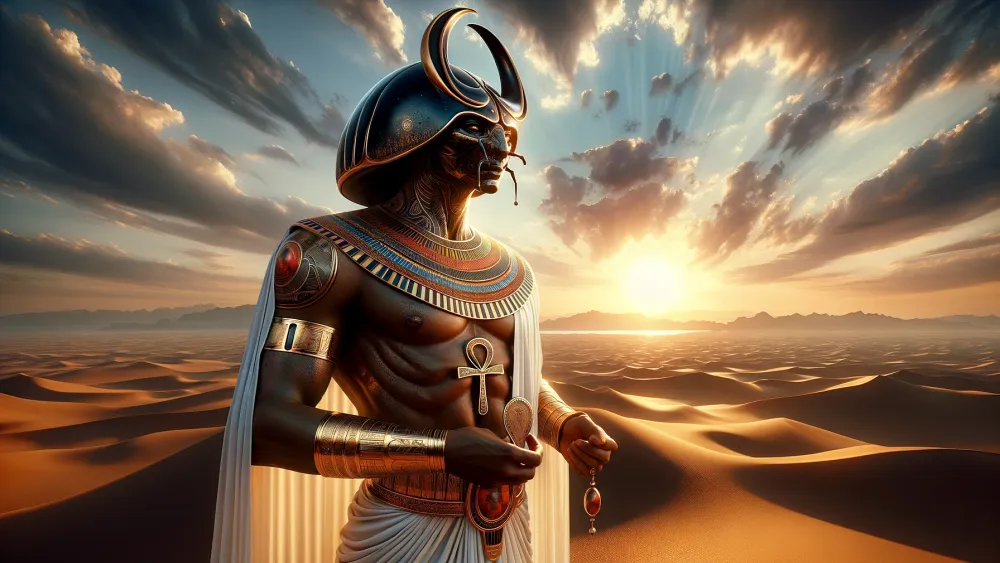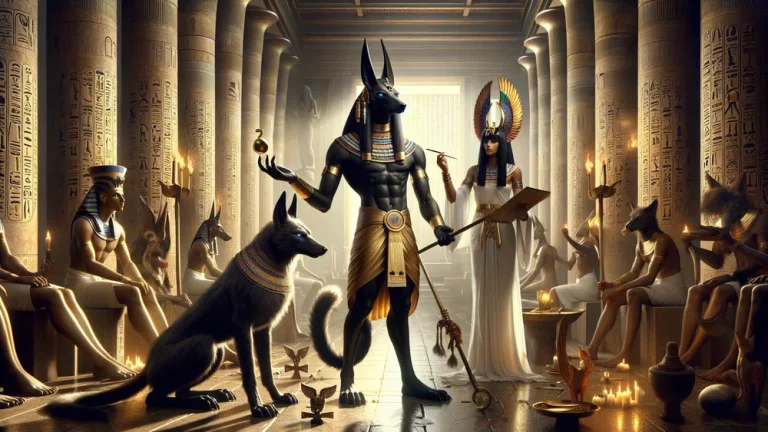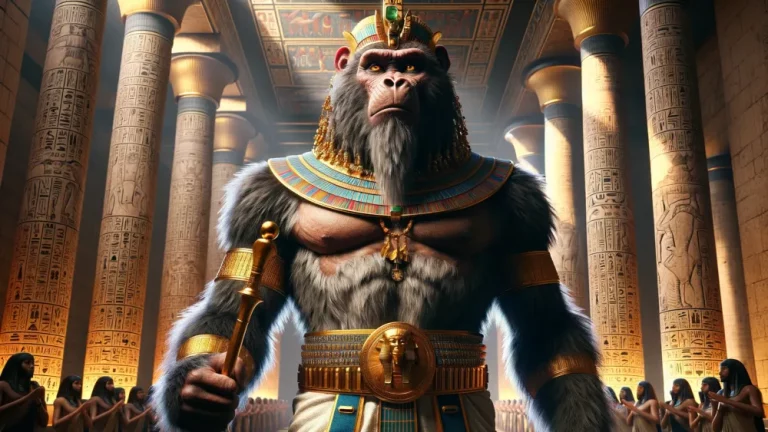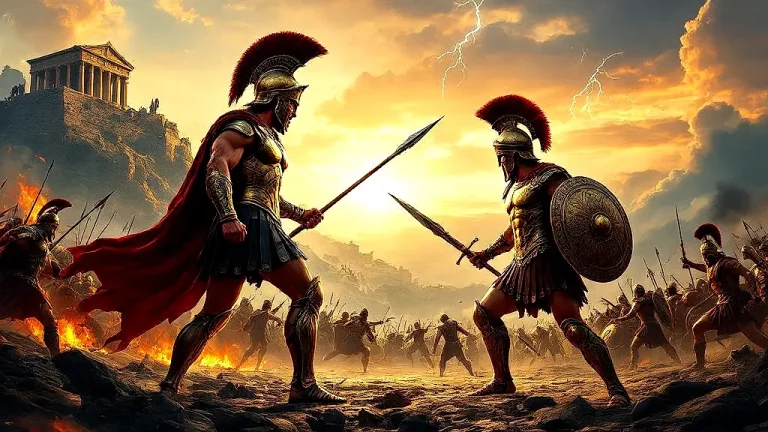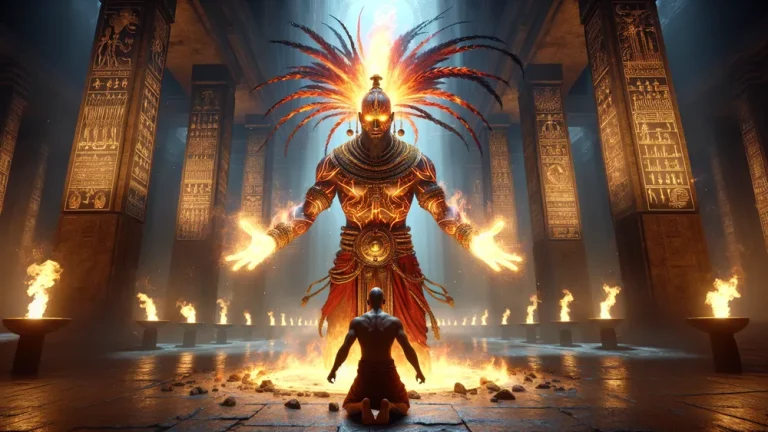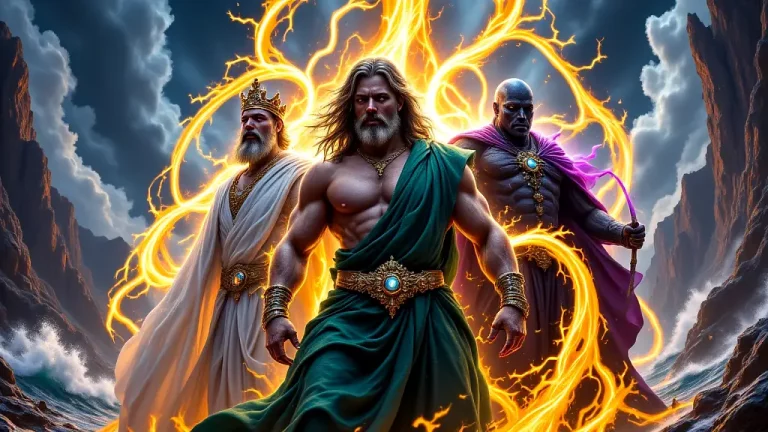Khepri: Egyptian God Of Sunrise And Rebirth
Think of the morning sun. Now, picture it being pushed up by some sort of higher force. In old Egyptian stories, this force has a name. They call it Khepri, who is the god of the morning sun. Khepri is a really interesting god because he stands for making things, changing, and being born again.
Key Points:
- Khepri is the ancient Egyptian god of the morning sun, symbolizing creation, change, and rebirth.
- His name comes from the word kheper, meaning to become or to create.
- Khepri is often represented as a scarab beetle or a man with a scarab beetle head in Egyptian art.
- He is connected to other sun gods like Ra and Atum, representing the daily cycle of the sun from morning to night.
- In funerary texts, Khepri plays a crucial role in guiding the dead through the underworld for rebirth in the afterlife.
- The scarab beetle symbolizes creation, change, and safety, and was used as an amulet for protection in ancient Egypt.
- Khepri’s symbolism is still relevant today, appearing in literature, art, and popular culture as a symbol of change and new beginnings.
This blog post will take you through where Khepri’s name comes from, what he looks like in old pictures, and his big role in their stories and religion. We’ll also check out his role in funeral writings, the beetle’s special meaning, and how people today are still touched by his story.
It doesn’t matter if you’re new to Egyptian stories or just want to know more, this big guide will help you see how Khepri, the god of the morning, still matters today.
khepri: Overview and Key Facts
| Main Point | Details |
|---|---|
| Name | Khepri |
| Meaning | Comes from the Egyptian word “kheper,” meaning “to become” or “to create” |
| Symbol | Scarab beetle |
| Role | God of the morning sun, creation, change, and rebirth |
| Depictions | Oftentimes shown as a scarab beetle or a man with a scarab head |
| Connected Deities | Ra (the sun god), Atum (the creator god) |
| Mythological Importance | Stands for the rising sun and the daily cycle of starting over |
| Funerary Texts | Listed in the Book of the Dead and the Amduat |
| Cultural Impact | Symbol of safety and renewal, used in jewelry and art |
| Modern References | Appears in today’s literature, art, and popular culture |
Getting to Know Khepri
To really understand Khepri, let’s look into his beginnings, meanings, and how he’s shown in old Egyptian culture.
Origins and Meanings
The name “Khepri” comes from the old Egyptian word “kheper,” which means “to become” or “to create.” This origin is more than a language detail; it shows Khepri’s true purpose. Think about a caterpillar turning into a butterfly; this change is similar to what Khepri stands for in the Egyptian gods.
He stands for making and changing things, showing the cycle of becoming and renewal that’s key to the natural world and the beliefs of ancient Egypt.
Khepri’s link with change and creation is strongly part of who he is. In old Egyptian stories, Khepri often is shown as a scarab beetle, which rolls dung into a ball and lays its eggs inside. This rolling act and the new life coming out of the dung ball is a clear example of making and being born again. To understand this better, here are some points on “kheper”:
- “Kheper” means “to become” or “to create.”
- It shows change and the process of beginning.
- It is key to the idea of being born again and renewal in old Egyptian beliefs.
By knowing where Khepri’s name comesto, you see his big role in the old Egyptian view, where he stands for the start of a new day and the endless life cycle.

Khepri’s name, originating from the Egyptian word kheper, signifies the concepts of transformation, creation, and renewal in the ancient Egyptian belief system.
What Khepri Looks Like
In old Egyptian pictures, Khepri is usually shown as a scarab beetle or a person with a scarab beetle head. The scarab beetle, also known as the dung beetle, was picked to show Khepri because of its special way of rolling dung into balls and putting eggs inside them. This act was seen as a sign of making and being born again, as new life came from what looked like lifeless dung.
Think of seeing a beetle rolling a ball of dung on the ground; this simple act captures what Khepri means in the Egyptian gods.

The beetle’s importance in Khepri’s image is more than its look. It’s a strong symbol of the morning sun and the idea of being born again. Just like the beetle rolls its dung ball, Khepri was thought to roll the sun across the sky, starting a new day. This daily sun journey was seen as a never-ending cycle of renewal and change, copying the natural ways of life and death. To get this better, here are some points on the beetle’s meaning:
- The beetle stands for making and new starts.
- It shows the daily new start of the sun.
- It has to do with the idea of never-ending life and renewal.
Besides the beetle, Khepri is sometimes shown with other signs that stress his part in making and changing things. For example, he might be seen with the sun disk, showing his link to the sun’s path. These pictures help to make Khepri known as a god of the morning sun and a sign of endless renewal.
By knowing these pictures, you see the deep meanings that old Egyptians put into their gods, making Khepri a strong figure in their stories.
Khepri’s Role in Myths and Religion
Khepri has a special place in the group of Egyptian gods, especially when thinking about his connection to other sun gods like Ra and Atum. Most people see Ra as the main sun god, representing the sun high in the sky, and Atum stands for the sun going down. Khepri, though, is tied to the rising sun.
This group of gods shows the whole daily cycle of the sun, from morning to night. Imagine the sun traveling across the sky like a relay race, where Khepri hands over to Ra at midday, and then Ra gives it to Atum in the evening. This smooth switch shows how these gods are linked and their joint part in keeping the world in order.
Khepri’s part in the sun’s daily journey is interesting and important. Being the god of the morning sun, Khepri is thought to push the sun up at dawn, starting a new day. This act is often shown as a scarab beetle rolling a ball, which means the sun, across the sky.
Just as each morning, you might get out of bed and begin your day, Khepri’s work means the world waking up and life starting again. The sun’s daily rebirth is a strong sign of the life cycles, death, and rebirth that are key to Egyptian stories about gods.
The stories around Khepri stress his part in making things and the idea of being born again and renewal. In some creation stories, Khepri is shown as a god who made himself and came out of the first chaos to make order in the world. This idea of making himself fits with the meaning of his name, “to become” or “to create,” and backs up his link to change.
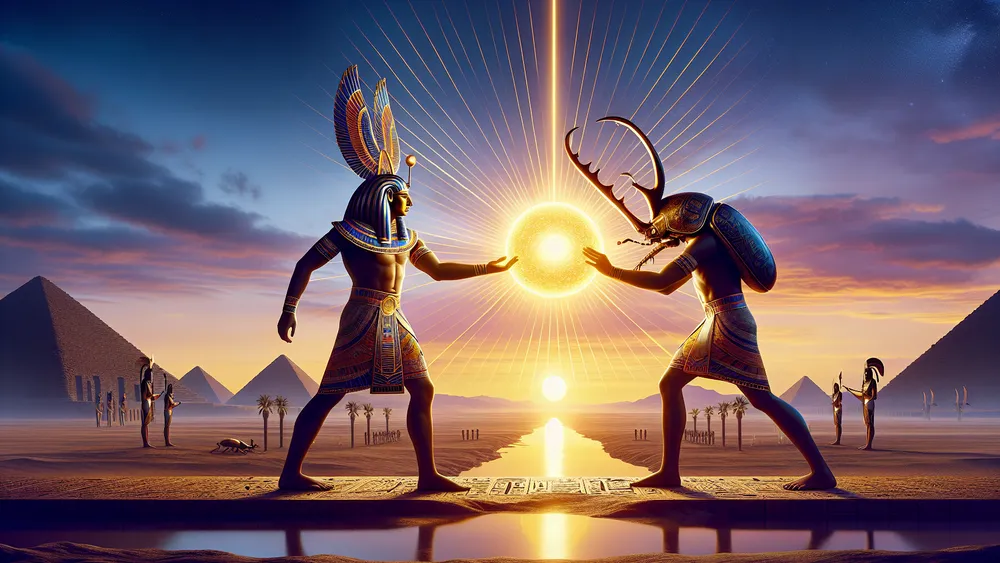
By knowing these stories, you can see how Khepri stands for the ideas of making and renewal, making him an important part of the old Egyptian belief system. His daily trip across the sky and his role in creation stories show the importance of never-ending cycles and the always-present chance for new starts.
Khepri’s Importance in Funerary Texts
To fully grasp Khepri’s significance, it’s essential to explore his role in ancient Egyptian funerary texts and beliefs about the afterlife.
Funerary Texts and Beyond
Khepri’s presence in old Egyptian death writings is both notable and important, showing his key role in the beliefs about life after death. In these writings, Khepri is often called upon to ensure the safe travel of the dead through the underworld and their final rebirth in the afterlife.
Think of the trip to the afterlife as a dangerous journey through unknown lands; Khepri acts as a guide, helping the soul move through the dark and come out renewed on the other side. One of the most known death writings mentioning Khepri is the Book of the Dead. These collected spells and incantations were made to help the dead overcome challenges in the afterlife.
Khepri is frequently shown in these writings as a symbol of rebirth, making sure the soul is changed and renewed. In the same way, the Amduat, which tells about the sun god Ra’s trip through the underworld, shows Khepri’s crucial part in the sun’s nightly rebirth. These writings show Khepri’s importance in the repeated nature of life, death, and rebirth, reinforcing his link to change.
During the trip through the underworld, Khepri is shown as a scarab beetle or a person with a scarab beetle head, symbolizing the process of change and renewal. Just as the scarab beetle rolls its ball of dung, Khepri is thought to roll the sun through the underworld, making sure it is reborn at dawn.
This picture serves as a clear sign for the soul’s journey in the afterlife, where it must face challenges and changes to reach everlasting life. By understanding Khepri’s role in these death writings, you get a deeper view of the ancient Egyptians’ beliefs about the afterlife and the always-powerful force of renewal and rebirth.
Symbolism and Impact on Culture
To better understand Khepri’s influence, it is crucial to look at the symbolism of the scarab beetle and its effect on both ancient and modern culture.
The Scarab Beetle Symbolism
The scarab beetle has a strong meaning in old Egyptian life. It stands for creation, change, and safety. This small bug, known for rolling dung, was seen as a powerful sign for the sun’s trek across the sky. Like how the scarab rolls its ball, Khepri, the god of the morning sun, was believed to push the sun from the horizon at dawn. This started the day and night cycle.
This link to the sun made the scarab a sign of Khepri, showing ideas of rebirth and renewal. Think of the scarab beetle as a hard worker, always pushing the sun to keep life going, just like daily tasks bring order to our lives.
The scarab beetle was also used a lot as amulets, believed to keep people safe and bring good luck. These amulets had prayers or spells and were placed with the dead to keep them safe in the afterlife. The safety of these amulets can be compared to modern charms people carry for luck or safety. The use of scarab amulets in old Egypt included:
- Personal Safety: Worn as jewelry to keep evil away and bring good luck.
- Death Rites: Placed with mummies to ensure a safe journey to the afterlife.
- Sign of Power: Used by kings and leaders as seals to show power and rightfulness.
By knowing what the scarab beetle stands for and how it was used, you get a better sense of its role in old Egyptian life and its lasting impact as a symbol of change and safety.
Khepri in Today’s World
Khepri’s symbolism has moved beyond old Egyptian life and entered modern books, art, and popular things. In books, Khepri often shows up as a symbol of change and new beginnings, matching his ancient role. For instance, some fantasy stories have characters or items linked with Khepri that can bring about big changes or rebirth.
In art, the scarab beetle, standing for Khepri, is often used in jewelry and tattoos, showing safety and the repeating nature of life. Picture a scarab beetle tattoo; it is not just a design but a modern nod to an old symbol of strength and change. The scarab beetle sign is still important today and is often used in fashion and design.
Scarab beetle designs can be seen on clothes, accessories, and even home items, reminding us of the lasting power of old symbols. These modern uses of the scarab beetle are similar to how we use symbols like the phoenix or the infinity sign – both are old symbols that now express timeless ideas.

Noticing these modern references and uses, you can understand how Khepri’s legacy continues, linking old beliefs with today’s culture.
Khepri’s symbolism, like that of the scarab beetle, remains relevant today, connecting ancient beliefs with modern culture through symbols of change and rebirth.
Pantheon of Egyptian Gods
The group of Egyptian gods is large and detailed, filled with many gods each having their own special features and stories. From the strong sun god Ra to the caring goddess Isis, these gods had important roles in the lives and beliefs of the ancient Egyptians.
To see the full list of all Egyptian gods and their interesting stories, you can visit this list of all the Egyptian gods. This complete guide will help you know the rich mix of characters in Egyptian mythology, like a big family where each one has a unique part and personality.
FAQs
1. Who is Khepri in Egyptian mythology?
Khepri in Egyptian mythology is the god of the morning sun, creation, and rebirth, often depicted as a scarab beetle.
2. What does Khepri symbolize?
Khepri symbolizes transformation, creation, and the daily rebirth of the sun.
3. How is Khepri depicted in ancient Egyptian art?
Khepri is depicted in ancient Egyptian art primarily as a scarab beetle or a man with a scarab beetle for a head.
4. What is the connection between Khepri and the scarab beetle?
The connection between Khepri and the scarab beetle lies in the beetle’s symbolic representation of the god’s role in creation, transformation, and the daily rebirth of the sun.

